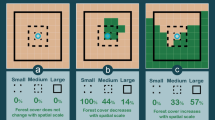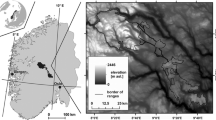Abstract
Geographic information systems (GIS) allow researchers to make cost-effective, spatially explicit predictions of species’ distributions across broad geographic areas. However, there has been little research on whether using fine-scale habitat data collected in the field could produce more robust models of species’ distributions. Here we used radio-telemetry data collected on a declining species, the North American wood turtle (Glyptemys insculpta), to test whether fine-scale habitat variables were better predictors of occurrence than land-cover and topography variables measured in a GIS. Patterns of male and female occurrence were similar in the spring; however, females used a much wider array of land-cover types and topographic positions in the summer and early fall, making it difficult for GIS-based models to accurately predict female occurrence at this time of year. Males on the other hand consistently selected flat, low-elevation, riparian areas throughout the year, and this consistency in turn led to the development of a strong GIS-based model. These results demonstrate the importance of taking a more sex-specific and temporally dynamic view of the environmental niche.



Similar content being viewed by others
Abbreviations
- GIS:
-
Geographic information systems
- SDM:
-
Species distribution model
References
Arvisais M, Bourgeois J-C, Levesque E, Daigle C, Masse D, Jutras J (2002) Home range and movements of a wood turtle (Clemmys insculpta) population at the northern limit of its range. Can J Zool 80:402–408
Arvisais M, Levesque E, Bourgeois J-C, Daigle C, Masse D, Jutras J (2004) Habitat selection by the wood turtle (Clemmys insculpta) at the northern limit of its range. Can J Zool 82:391–398
Austin M (2007) Species distribution models and ecological theory: a critical assessment and some possible new approaches. Ecol Model 200:1–19
Betts MG, Diamond AW, Forbes GJ, Villard M-A, Gunn JS (2006) The importance of spatial autocorrelation, extent and resolution in predicting forest bird occurrence. Ecol Model 191:197–224
Buckland-Nicks LH (1995) A community based management plan for the fisheries in the St. Mary’s River. St. Mary’s River Association, Sherbrooke, NS
Burnham KP, Anderson DR (2002) Model selection and multimodel inference: a practical information—theoretic approach, 2nd edn. Springer-Verlag, New York
Compton BW, Rhymer JM, McCollough M (2002) Habitat selection by wood turtles (Clemmys insculpta): an application of paired logistic regression. Ecology 83:833–843
Daigle C, Jutras J (2005) Quantitative evidence of decline in a Southern Québec wood turtle (Glyptemys insculpta) population. J Herpetol 39:130–132
Dormann CF (2007) Promising the future? Global change projections of species distributions. Basic Appl Ecol 8:387–397
Ferrier S (2002) Mapping spatial pattern in biodiversity for regional conservation planning: where to from here? Syst Biol 51:331–363
Fortin D, Beyer HL, Boyce MS, Smith DW, Duchesne T, Mao JS (2005) Wolves influence elk movements: behavior shapes a trophic cascade in Yellowstone National Park. Ecology 86:1320–1330
Garber SD, Burger J (1995) A 20-yr study documenting the relationship between turtle decline and human recreation. Ecol Appl 5:1151–1162
Greaves WF (2007) A cold and harsh environment: demography and spatial ecology of a northern population of wood turtles (Glyptemys insculpta). Dissertation, Laurentian University
Guisan A, Zimmermann NE (2000) Predictive habitat distribution models in ecology. Ecol Model 135:147–186
Guisan A, Broennimann O, Engler R, Vust M, Yoccoz NG, Lehmann A, Zimmermann NE (2006) Using niche-based models to improve the sampling of rare species. Conserv Biol 20:501–511
Harvey DS, Weatherhead PJ (2006) A test of the hierarchical model of habitat selection using eastern massasauga rattlesnakes (Sistrurus c. catenatus). Biol Conserv 130:206–216
Jeganathan P, Green RE, Norris K, Vogiatzakis IN, Bartsch A, Wotton SR, Bowden CGR, Griffiths GH, Pain D, Rahmani AR (2004) Modeling habitat selection and distribution of the critically endangered Jerdon’s courser Rhinoptilus bitorquatus in scrub jungle: an application of a new tracking method. J Appl Ecol 41:224–237
Johnson JB, Omland KS (2004) Model selection in ecology and evolution. Trends Ecol Evol 19:101–108
Johnson CM, Johnson LB, Richards C, Beasley V (2002) Predicting the occurrence of amphibians: an assessment of multiple-scale models. In: Scott JM, Heglund P, Morrison ML (eds) Predicting species occurrences: issues of accuracy and scale. Island Press, DC
Johnson CJ, Seip DR, Boyce MS (2004) A quantitative approach to conservation planning: using resource selection functions to map the distribution of mountain caribou at multiple spatial scales. J Appl Ecol 41:238–251
Kaufmann JH (1992) Habitat use by wood turtles in central Pennsylvania. J Herpetol 26:315–321
Mitchell MS, Lancia RA, Gerwin JA (2001) Using landscape-level data to predict the distribution of birds on a managed forest: effects of scale. Ecol Appl 11:1692–1708
Mladenoff DJ, Sickley TA, Haight RG, Wydeven AP (1995) A regional landscape analysis and prediction of favorable gray wolf habitat in the northern Great Lakes region. Conserv Biol 9:279–294
Pasinelli G (1999) Sexual dimorphism and foraging niche partitioning in the Middle Spotted Woodpecker Dendrocopus medius. Ibis 142:635–644
Quinn NW, Tate DP (1991) Seasonal movements and habitat of wood turtles (Clemmys insculpta) in Algonquin Park, Canada. J Herpetol 25:217–220
R Development Core Team (2007) R: a language and environment for statistical computing. R Foundation for Statistical Computing, Austria
Saumure RA, Herman TB, Titman RD (2007) Effects of haying and agricultural practices on an imperiled species: the North American wood turtle, Glyptemys insculpta. Biol Conserv 135:165–175
Saveraid EH, Debinski DM, Kindscher K, Jakubauskas ME (2001) A comparison of satellite data and landscape variables in predicting bird species occurrences in the Greater Yellowstone Ecosystem, USA. Landsc Ecol 16:71–83
Seoane J, Bustamante J, Diaz-Delgado R (2004) Competing roles for landscape, vegetation, topography and climate in predictive models of bird distribution. Ecol Model 171:209–222
Strang CA (1983) Spatial and temporal activity patterns in two terrestrial turtles. J Herpetol 17:43–47
Tingley R, McCurdy DG, Pulsifer MD, Herman TB (2009) Spatio-temporal differences in the use of agricultural fields by male and female wood turtles (Glyptemys insculpta) inhabiting an agri-forest mosaic. Herpetol Conserv Biol 4:185–190
Walde AD, Bider JR, Masse D, Saumure RA, Titman RD (2007) Nesting ecology and hatching success of the wood turtle, Glyptemys insculpta, in Québec. Herpetol Conserv Biol 2:49–60
Weisberg S (1980) Applied linear regression. Wiley Publishing, New York
Acknowledgments
This research was funded by the Nova Forest Alliance, Stora ENSO, the Elizabeth Wakeman Foundation, the Nova Scotia Habitat Conservation Fund, the Government of Canada Habitat Stewardship Program for Species at Risk, the Saint Mary’s River Association, the Nova Scotia Department of Natural Resources and an Acadia Graduate Award to RT. K. Krumb, L. Sweet and M. Lupek assisted with the field component of this research. B. Starzomski, D. Shutler, and D. Pike helped revise an earlier version of this manuscript.
Author information
Authors and Affiliations
Corresponding author
Rights and permissions
About this article
Cite this article
Tingley, R., Herman, T.B., Pulsifer, M.D. et al. Intra-specific niche partitioning obscures the importance of fine-scale habitat data in species distribution models. Biodivers Conserv 19, 2455–2467 (2010). https://doi.org/10.1007/s10531-010-9852-7
Received:
Accepted:
Published:
Issue Date:
DOI: https://doi.org/10.1007/s10531-010-9852-7




